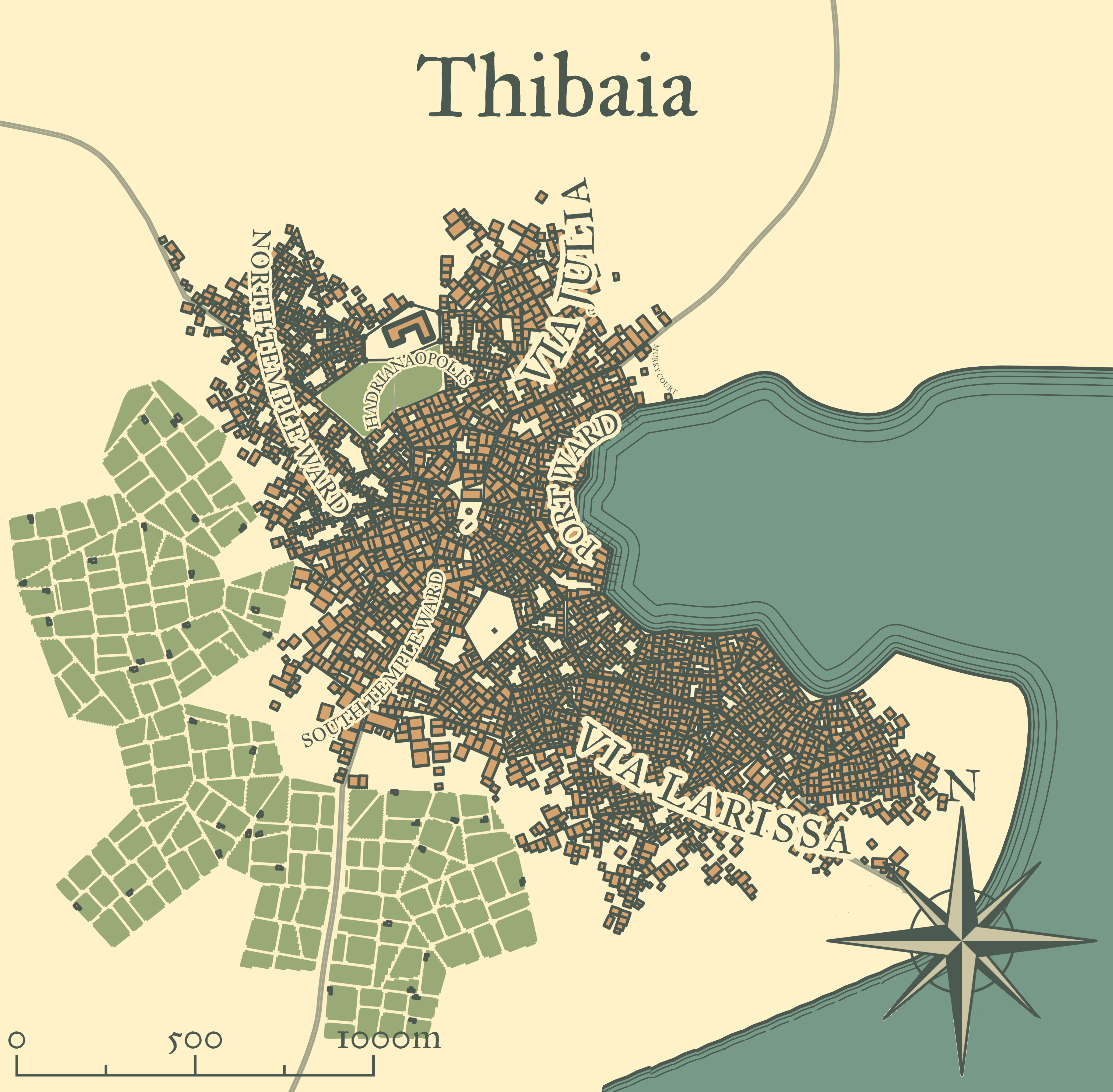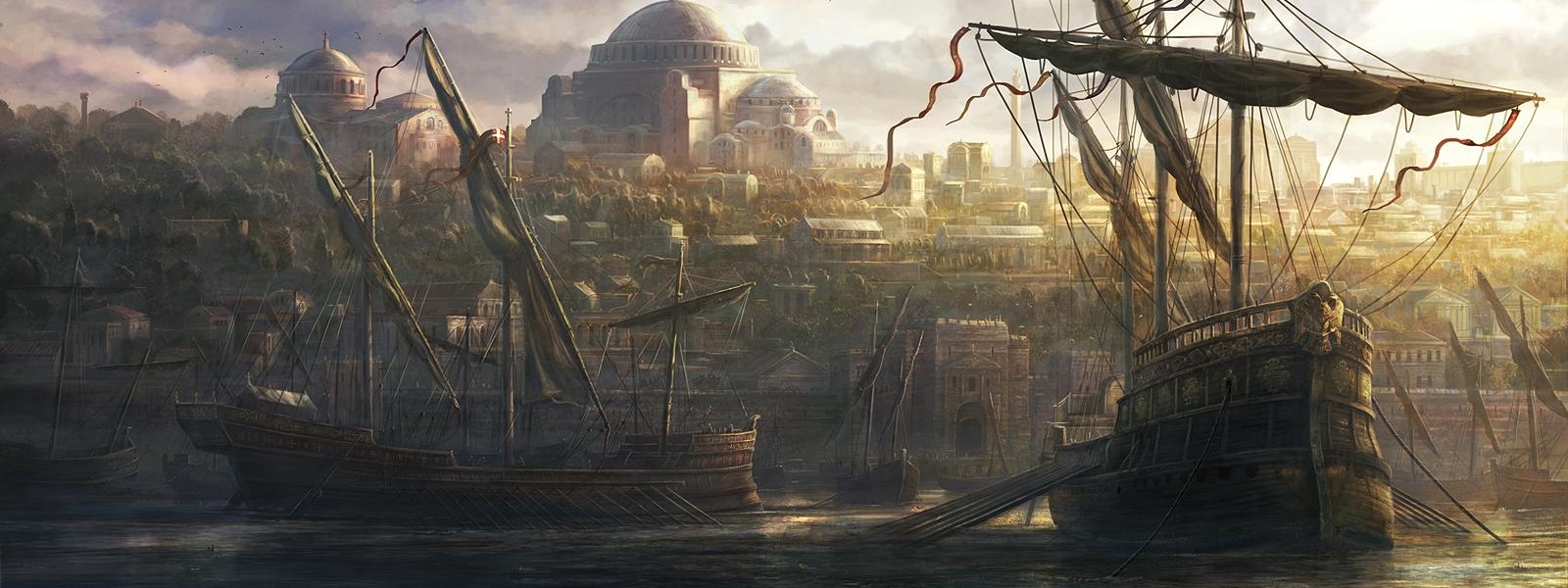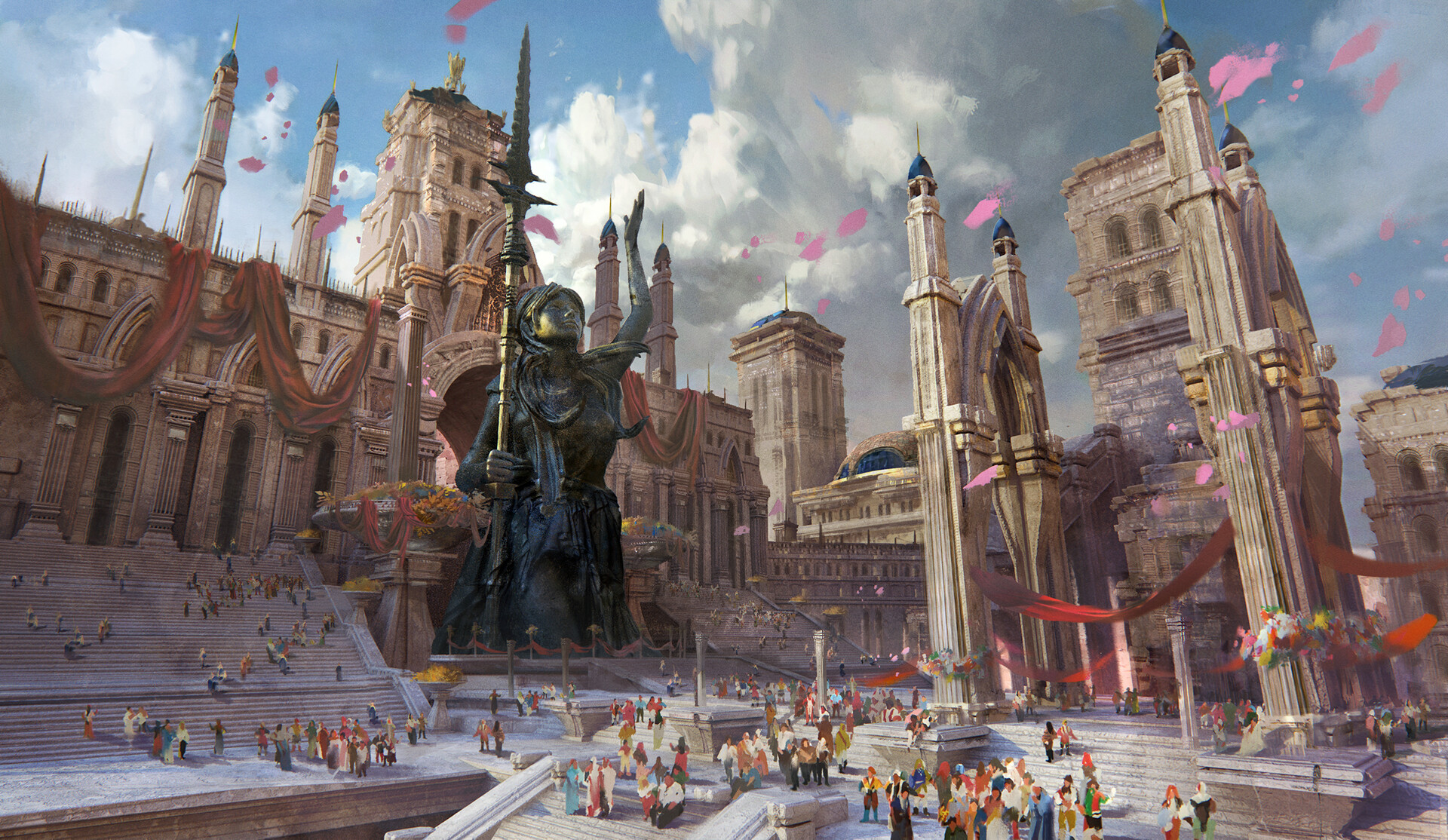Thibaia (/ θɪbaiə /)
Φιμπαϊα
As you pass into the Holy City, you find yourself in a vibrant and colorful landscape draped in the colors of the several deities in the Pandroi faith. Every which way pilgrims travel to the various shrines, temples, and holy sites in the city, beautifully vests priests and vestals guide these souls, and heavily armored holy warriors patrol the streets as much to cut an impressive view for the faithful as to keep order.The city of Thibaia, also known as the Holy City, is one of the most important locales in the Pandroi faith, and therefore one of the most politically influential cities in the whole of the Aeillan region. It is the capital of the theocratic Thibaian Divinity League and is the largest city on the coast of the Bay of Storms. Pilgrims from all over the Pandroi world come to this city to worship, and to walk amongst the hallowed streets.
Wards of Thibaia
The city of Thibaia has five major, and one minor ward. Most of the city's wards, save the newer, outer wards are based around the temples that make the city so important. Most of the less sacred activity occurs in the outer wards.The Hadrianaopolis: The heart of the city, with the old palace, remade into a temple dedicated to the Aeillan Pandroi goddess Hadriana, the Hadrianaopolis is essentially a massive semi-connected religious complex with a number of smaller temples, knightly chapter houses, and other structures connected.
South Temple Ward: Located closer to the sea, and at a lower elevation, the South Temple Ward is largely home to temples dedicated to more naturalistic deities of the land, sea, and sky, with larger green spaces to many other places, and with easy access to most of the surrounding farms.
North Temple Ward: Near the Hadrianaopolis lies the North Temple Ward. Hosting most of the temples dedicated to more mortally aligned deities, the North Temple Ward also houses many of the city's catacombs.
Port Ward: Located around the city's docks the Port Ward is where much of the economic activity not tied to religion occurs. Here, goods are offloaded and loaded onto ships, and many market stalls have been set up in order to sell goods to the city's residents.
Via Julia: Set up to accommodate pilgrims from the northern pilgrimage, the Via Julia is home to many homes, inns, and markets, including those selling false religious relics to unwitting pilgrims.
Via Larissa: Similar to the Via Julia, the Via Larissa is primarily a pilgrimage servicer and host to a fair amount of the city's commercial activity.
Important Locations
The Temple to Hadriana: The religious and political heart of the city, the Temple to Hadriana is the largest such temple in the whole of the Aeillan region, and possibly in the known world. It is one of the best places to obtain the service of clerics of Hadriana.The Knights of the Argent Raven Headquarters: Next to the Temple of Hadriana is the headquarters for the Knights of the Argent Raven, here one can obtain a number of relatively dangerous quests, as well as meet with the ancient and enigmatic leader of the Argent Raven, Annwyn.
The Statue of the Twin Goddesses: A statue raised up in honor of the goddesses of moon and sun, Isaura and Poleo, the statue of the twin goddesses is a site frequented by pilgrims, it is believed that leaving coins at the base of the statue guarantees good fortune and healthy children.
The Relic Emporium: A market in the Via Julia that claims to be a one-stop shopping place for religious artifacts. Most often these claims are patently false of course, but those in the know, and willing to grease the right palms may be able to get their hands on real religious artifacts.
The Temple of Sio: Dedicated to the deity of broken chains, the Temple of Sio, who in this is worshipped in their feminine aspect. It is a good place to obtain the services of clerics, who often perform services more cheaply than those of other temples. It is also rumored to be a safe harbor for slaves fleeing from the slaver states up the Tyros River.
The Fields of Conquest: Established south of the city, the fields of conquest are legally sanctioned grounds upon which those seeking battle in the name of the gods may do so under the watchful eyes of the priesthood. There are some who watch the trials of honor, though the practice is frowned upon by the city's leadership.
Demographics
The city of Thibaia has a vast population, some 86,100 souls, though a fair number of these are only semipermanent residents. The city of Thibaia is a free city, but does not guarantee full citizenship to all free citizens, rather only those serving the various temples in some capacity (roughly 14,120 in total) are full citizens of the Divinity League, with the rest of the population noncitizen freemen. Freemen are however, granted a great deal more liberty than non-citizens of most other successor states. The population is largely Tyroi and Ilosi Aeillan in nature with smatterings of other peoples, particularly among the migrant population.
Government
The government of Thibaia is relatively unique in the world, in that it is governed directly by powerful religious leaders. Instead of having an Exarch, the city is run by the various temples of the city, with the most influential being declared the de facto Ecclesiarch of Aeilla. Currently the reigning Ecclesiarch is whomever leads the Temple of Hadriana, who is at this time Maximos Angevoi, a moderate reformist, seeking to modernize the Temple City, and allow it to maintain its tight grip on its power and influence to the Pandroi faithful.
Defences
The city of Thibaia lacks walls to defend itself. Instead, Thibaia relies on its defenders. Thanks to the high concentration of temples, and an agreement between then, each temple maintains a force of paladins that can be called into the defense of the city if necessary, these warriors are small in number, with only a few hundred among them, however, as they are magically empowered paladins they frequently prove themselves worth many times more than even professional soldiers. They are supplemented by the less gifted members of their Holy Orders, who are, nonetheless quite skilled themselves. The city also maintains a small urban militia and city watch that can be called to defend the city.
Industry & Trade
The city's primary industries are geared towards the care of, and trade with pilgrims migrating into the city in large numbers every year to see temples. Indeed, there are a vastly disproportionate number of inns servicing wealthy and impoverished patrons alike, as well as markets selling artifacts to them. In addition to the tourism of the city, Thibaia also has a modest agricultural sector, and a relatively decent number of skilled craftspeople, including the venerable forge priests of Rauranos and priest-tenders of Maia, producing food, and manufactured goods for the city, though fewer than could be expected of a city Thibaia's size. Goods produced here however, are of excellent quality.
Infrastructure
The city of Thibaia possesses heavy class divisions. In the relatively wealthy, established, parts of the city, there is running water, including fountains, good sewer systems, and streetlights. As the city expanded however, the relative lack of governance meant that for the longest time infrastructure was not expanded. As a result the Via Julia and Via Larissa are comparatively underdeveloped. Efforts are underway to improve the infrastructure in these areas as well however, with the banks and temples generously donating to the cause for the good of the city.
Guilds and Factions
The city's government is largely composed of competing temples, religious orders, and martial orders, each of which wants influence over the policy direction of the city. With the more influential deities with the larger followings generally having more power, and those of less influential deities seeking intrigue instead to secure their path to power and influence. Competition is kept in check by law and custom, and as a result this conflict over influence is kept largely civil, and almost entirely peaceful, with little in the way of bloodshed.
History
The city of Thibia was founded during the Forging Era. Initially it was a relatively small fishing and agricultural settlement. An unusually high number of miraculous events occurring near the city however made it a focal point for the faithful of the young Pandroi faith, causing an influx of new travelers into the city, and, as a result increasing the rate at which the city began to grow. New temples were built at a rapid peace as people sought out places to pray after completing their journeys, and several martial orders were founded here with the covenants of fraternity strengthened by the holiness of the ground upon which they were sworn.
The city of Thibaia was officially declared a holy city furing the High Imperial period, and indeed a fair few among the clergy moved into the city. The Empire itself began to back the construction of infrastructure in the city, resulting in the construction of vast stone temples, advanced infrastructure making the whole the city seem a more beautiful and prestigious place. This trend continued into the Late Imperial as well, with public works projects being funded for the Holy City of Thibaia even as the economy softened.
When the Aeillan Empire fell, the city of Thibaia found itself under the control of the Exarchate of Korentis. Caught up in the power struggle between Korentis itslef, and Antiokus, the Thibaians struggled. However, in the second century of the Reforging Era, a group of powerful religious figures ousted the Exarch appointed government, establishing a new theocratic over over the land. This new theocratic state would create the codes that would result in the formation of the modern divinity league and transform Thibaia into a political as well as cultural center.
Geography
The city of Thibaia was build up around the coast, near a small bay close to the mouth of the River Tyros, as a result it has ready access to the water. The city was built up along the highlands overloaking the port, eventually building up the whole of the highlands. As the Reforging Era continued additional residences and businesses were built closer and closer to the coast, filling in the land between the highlands and the sea.

Map of Thibaia by Javak
Founding Date
EF 195
Alternative Name(s)
The Holy City
Type
Large city
Population
86,078
Inhabitant Demonym
Thibaian, Thibaians
Location under
Owner/Ruler
Owning Organization



